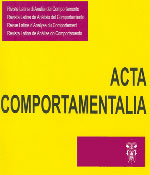Observing response: A reappraisal
Main Article Content
Abstract
Observing response is an operant behavior that has the production of discriminative stimuli as consequence. The present paper review the long course of scientific production in this research field, from the precursor investigations with rats in mazes up to the most recent works. To analyze the high and diverse existing literature, the paper uses the strategy of identifying and describing the three basic observing-response procedures often employed. In the sequence, findings are grouped and analyzed according to the four species of subjects mostly used: pigeons, humans, monkeys, and rats. By doing so, three main questions in the field are discussed: (a) the possible maintenance of observing response by S-; (b) the possible reinforcing function of S- on primates in particular; (c) the adequacy of current models of conditioned reinforcement, mainly the Delay- Reduction Model and the Uncertainty-Reduction Model, to describe conditioned reinforcement. In short, the present analysis shows that S- either does not exert reinforcing functions or exert aversive functions on observing responses, except in particular circumstances. These circumstances in which S- maintains observing responses were verified both in humans and non-human subjects. Therefore, that the conditioned reinforcing value of S- is species specific does not sustain, as it does not sustain the attempts to comprehend the complex relations of contingencies that involve observing responses by taking any theoretical model alone.
Article Details
How to Cite
Yukio Tomanari, G. (2010). Observing response: A reappraisal. Acta Comportamentalia, 17(3). Retrieved from https://revistas.unam.mx/index.php/acom/article/view/18153
Citas en Dimensions Service

<a rel="license" href="http://creativecommons.org/licenses/by-nc-sa/4.0/"><img alt="Licencia de Creative Commons" style="border-width:0" src="https://i.creativecommons.org/l/by-nc-sa/4.0/88x31.png" /></a><br />Este obra está bajo una <a rel="license" href="http://creativecommons.org/licenses/by-nc-sa/4.0/">licencia de Creative Commons Reconocimiento-NoComercial-CompartirIgual 4.0 Internacional</a>.
